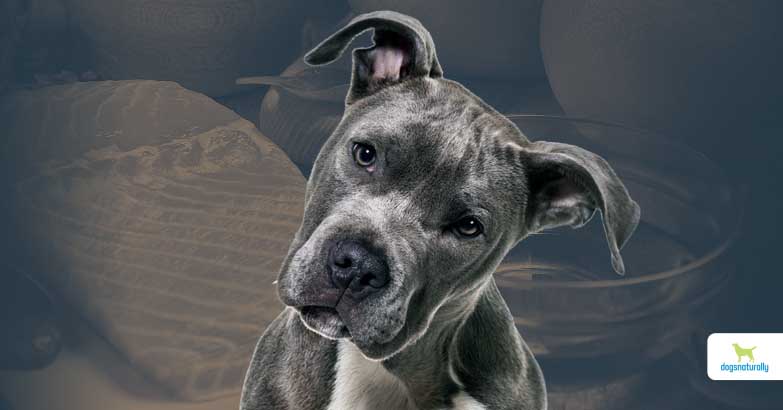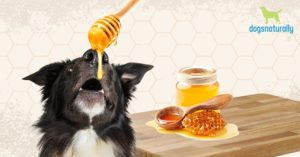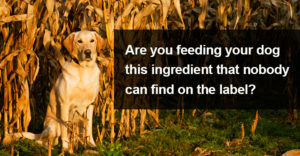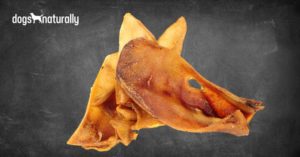Fats are the second most important part of your dog’s diet, next to protein. In the wild, nearly half the calories wild dogs eat are from fat. But given the importance of fat in the diet, it’s surprising how so many of us make the same mistake. And this mistake can create dangerous inflammation in your dog.
So let’s take a look at omega-3 fats for dogs, and the other fats you need to balance … and see how critical this delicate balance is to your dog’s health.
Why Your Dog Needs Fats
There are just three sources of energy or calories for your dog: protein, fat and carbohydrate.
Protein provides calories and also the building blocks for virtually every structure in your dog’s body. They build muscles and soft tissue, skin, hair and nails, blood cells, neurotransmitters and the enzymes that control virtually every action in the body.
Fat also provides energy — and it does much more than just store fat for energy. Fats (or lipids) function as chemical messengers, they form the membranes of all the body’s cells, they help the body absorb fat soluble vitamins (A, D, E and K), and they control hormones and play a huge role in inflammation.
Carbohydrates provide energy only — they play no other role in the body.
So getting proteins and fats right is critical to your dog’s health — they’re the building blocks for good nutrition. And getting the fats right means not just the amount of fat, but the balance. Let’s take a look …
Types Of Fats
There are various types of fats in the body, but the dietary fat we refer to most often is called a triglyceride. This fat is made up of a glyceride molecule with three tails of fatty acids attached to it (tri-glyceride). There are two types of triglycerides: saturated and unsaturated.
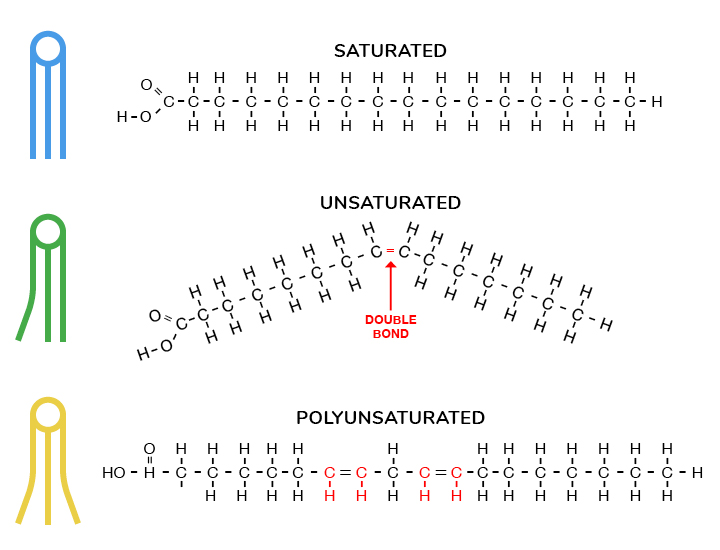
Saturated fats have straight tails and this means they can pack tightly together. Unsaturated fats have kinks in their tails because some of the carbon bonds in them double up, causing the kinks. Monounsaturated fats have just one kink, but polyunsaturated can have over 20 kinks, or double bonds. The kinks in fatty acids prevent them from packing closely together. So saturated fats are solid at room temperature (like butter or lard) and polyunsaturated fats are usually liquid at room temperature.
Your dog needs both saturated and unsaturated fats. But things tend to go wrong with the polyunsaturated fats and this creates health issues. Let’s take a closer look …
Polyunsaturated Fats (PUFAs)
The PUFAs can be divided into two main types: omega-6 and omega-3.
Omega-6 fats include linoleic acid and arachidonic acid. Omega-3 fats include alpha-linolenic acid, eicosapentaenoic acid (EPA) and docosahexaenoic acid (DHA).
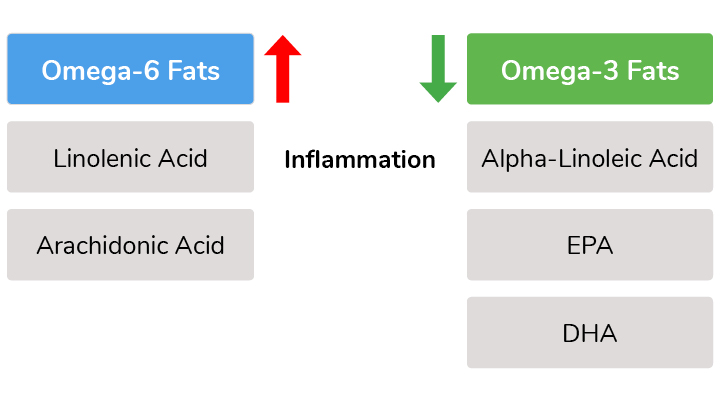
Both omega-6 and omega-3 fats have the ability to control hormones — and the hormones they control have very different jobs. The omega-6 fatty acids produce hormones that increase inflammation, which is an important part of the immune response. They also help with blood clotting and cell growth. The hormones produced by omega-3 fatty acids also control the immune system and they work alongside the omega-6 fats in an antagonistic manner. So, balance between these fatty acids is an important part of a healthy immune system. Both fats are important and your dog needs both in his diet. But these fats must be reasonably balanced for a balanced immune system … and today’s modern diets make this balance difficult.
Now let’s compare these wild animals to the farmed animals we feed our dogs. Compared to the wild deer and elk, beef contains much lower amounts of both omega-6 and omega-3. And the ratio of omega-6 to omega-3 fats in grain-fed beef at 7:1 is double the level in the wild game.
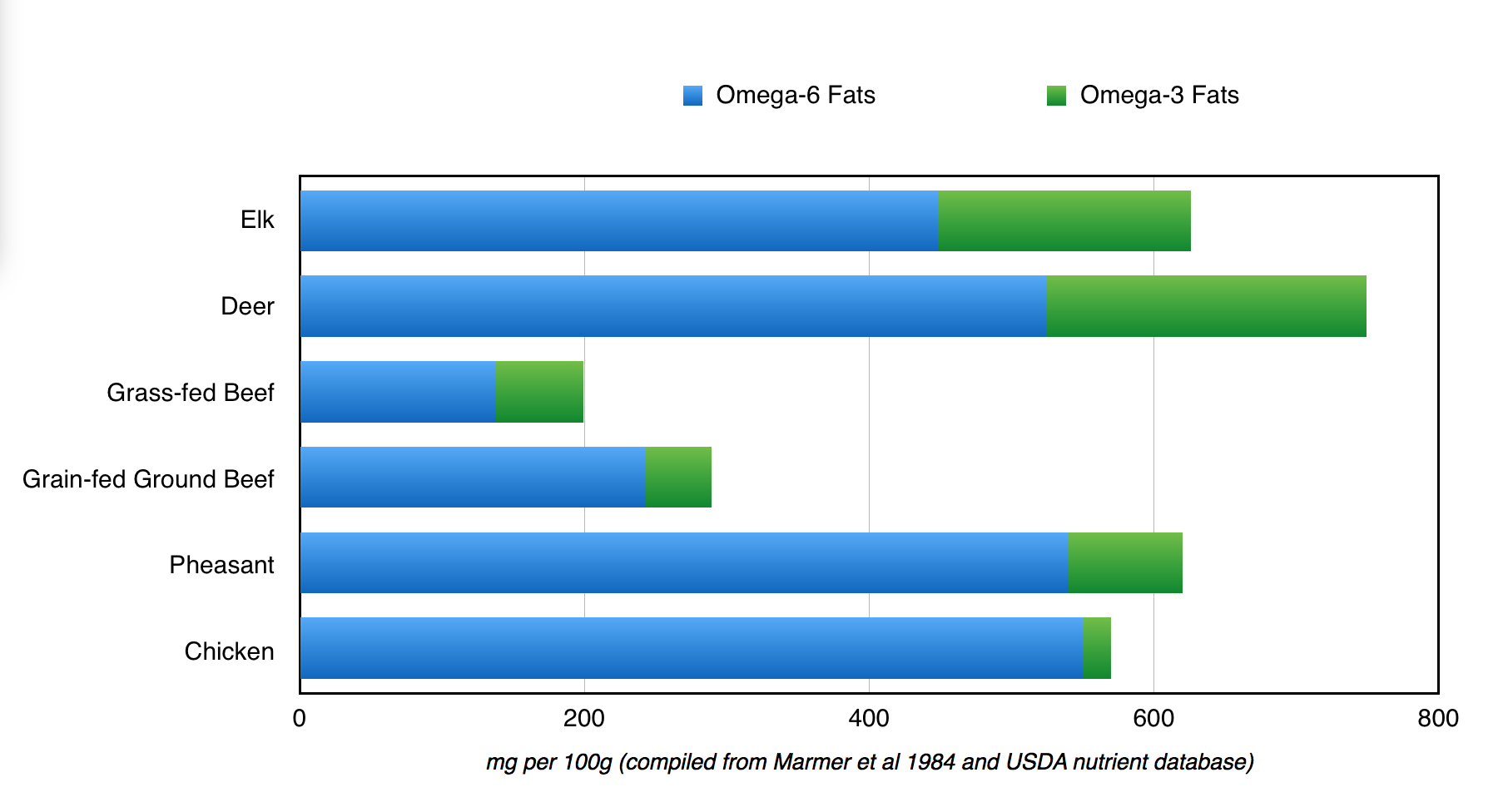
And if we look at chicken, we can see that it’s much higher in omega 6 than the deer and beef, but contains less omega-3. And it contains much less omega-3 fat than pheasant. In fact, the 6:3 ratio in chicken is a whopping 28:1.
Here’s why this is a problem …
Omega-3 Fats And Inflammation
Remember, omega-6 and omega-3 fats work together in your dog to control inflammation. Omega-6 fats raise inflammation while omega-3 fats lower it. If there’s too much omega-6, the hormones that raise inflammation will be turned on and if there’s too much omega-3, there will be immune dysfunction.
Not all inflammation in the body is a bad thing. If your dog is exposed to viruses or bacteria, inflammation brings white blood cells to the area as an important part of the immune process.
But chronic inflammation – the kind of inflammation that stays for weeks, months and even years – is the cause of most degenerative and inflammatory health issues in your dog, including allergies, arthritis, inflammatory bowel disease, heart disease, diabetes, liver or kidney disease and cancer. So the omega fats must be balanced or your dog’s immune system won’t be balanced.
So let’s take a close look at that balance and we’ll start by comparing deer and beef. We used lean ground beef and you can see that the beef only contains a bit more fat overall than the deer meat. But the composition of that fat is very different in the wild deer compared to the domestic cow.
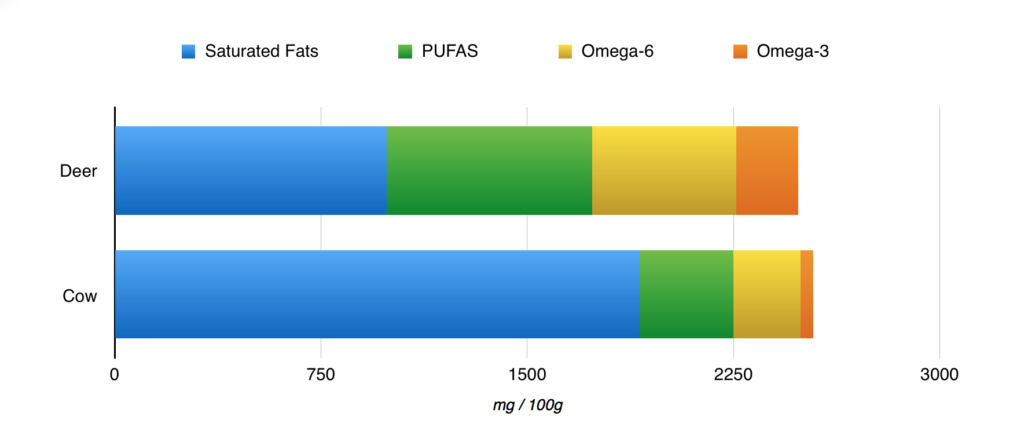
You can see the beef contains double the amount of saturated fat and about half the amount of PUFAs. And if we look at the PUFAs, we can see that the beef contains much less omega-6 than the deer and a higher ratio of omega-6 to omega-3. And when the 6:3 ratio is unbalanced, it can cause chronic inflammation.
Now let’s compare wild and domestic poultry:
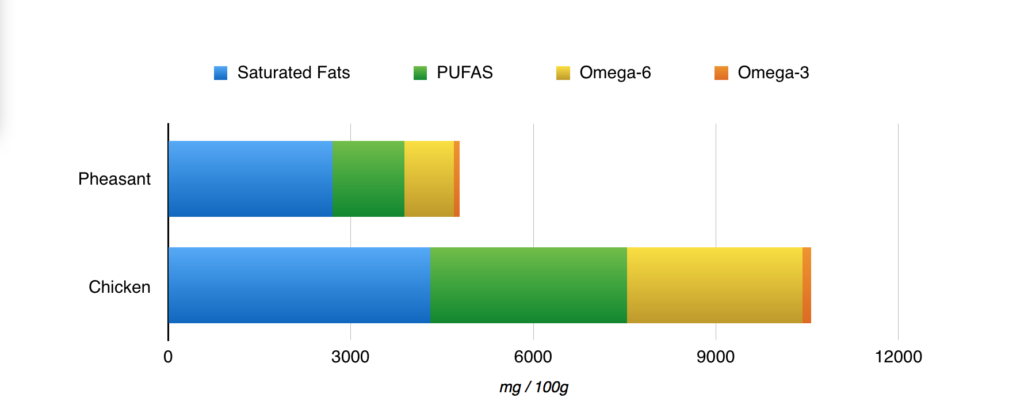
Compared to the pheasant, the domestic chicken contains much more fat overall and it contains a much higher percentage of PUFAs. And if you compare the amount of omega-6 to omega-3, there’s four times more omega-6! So once again, your dog will be eating food that’s too high in omega-6 fats. This will create chronic inflammation and, sooner or later, it will cause
So why do food animals contain this harmful combination of fats?
There are definitely differences between the animals we eat today and the animals our ancestors ate centuries ago. But by a landslide, the biggest difference is the foods we feed them.
In the wild, ruminants would eat grasses (ruminants are animals with a rumen, like cattle, deer, goats and sheep). But most ruminants today, even grass-fed ones, spend their last days eating grain, soy and corn. They would eat very little of this in the wild, but they’re fed huge amounts before they’re slaughtered, to make their meat fattier and tastier (at least to humans).
Check this out …
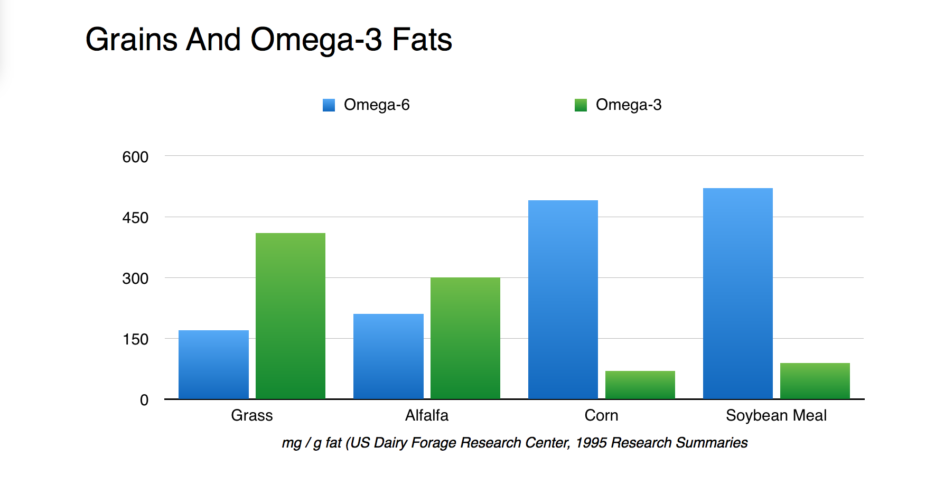
This is a comparison of the omega-6 and omega-3 levels in grasses and grains. You can see that grass and alfalfa contain more omega-3 than omega-6 … but the corn and soy our food animals eat contains much more inflammatory omega-6 fats and only a fraction of the omega-3 fats.
When cows, chickens, pigs and other food animals are forced to eat these foods, it changes their fats. And ultimately, it will change the fats in your dog when he eats them. Those deficiencies are passed right up through the food chain. And this is especially ironic if you’re feeding a raw diet … because your dog will suffer the same health issues from eating grain-fed animals as he would if he ate the grains himself!
Now if you’re getting a little depressed about this, don’t! I’ll show you how you can fix the fats in your dog’s food. But before I do, let’s take a quick moment to talk about dogs eating commercial foods.
Fats In Processed Diets
The Association of American Feed Control Officials (AAFCO) provides nutritional standards (called model bills and regulations) that pet food manufacturers must abide by if they want to advertise their food as “complete and balanced.”
Pet foods don’t just contain animals with unbalanced fats … they contain grains and foods that also include unbalanced fats. This is mostly to keep costs down — and the folks at AAFCO seem to be fine with this … because they don’t care unless the omega-6 to omega-3 ratio exceeds a whopping 30:1. If that doesn’t alarm you, I’ll put it in perspective: if you fed your dog nothing but chicken skin, the 6:3 ratio would actually be healthier than AAFCO requirements because chicken skin has a ratio of 24:1.
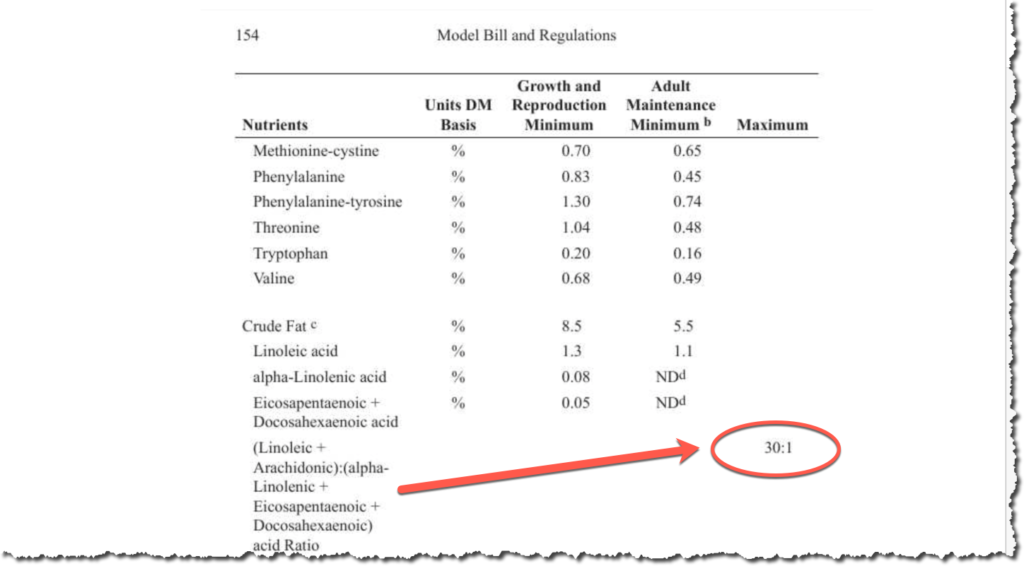
So if you feed our dog a commercial dog food, it will likely be too high in pro-inflammatory omega-6 fats. And if you feed your dog raw meats that aren’t raised 100% on pasture, they’ll be too high in pro-inflammatory omega-6 fats. And this puts him at risk for nearly every chronic disease.
So now what?
Balancing The Fats In Dogs
Fortunately, you can do a little tweaking to your dog’s diet … and it’s actually quite easy! Let’s start with beef (and you can follow the same rules for lamb and goat).
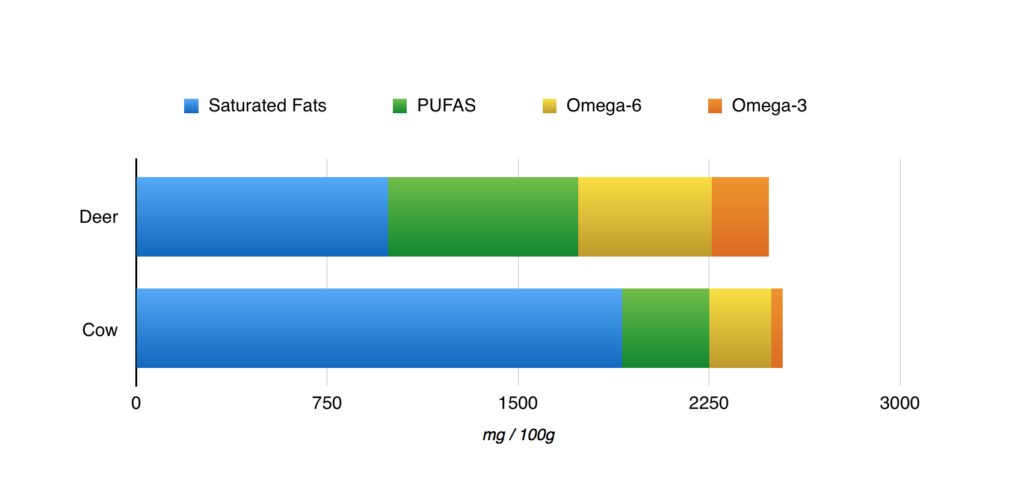
Compared to deer and other wild ruminants, beef, lamb and goat meat are high in saturated fat, low in PUFAs and low in omega-3 fats.
Now let’s look at poultry:
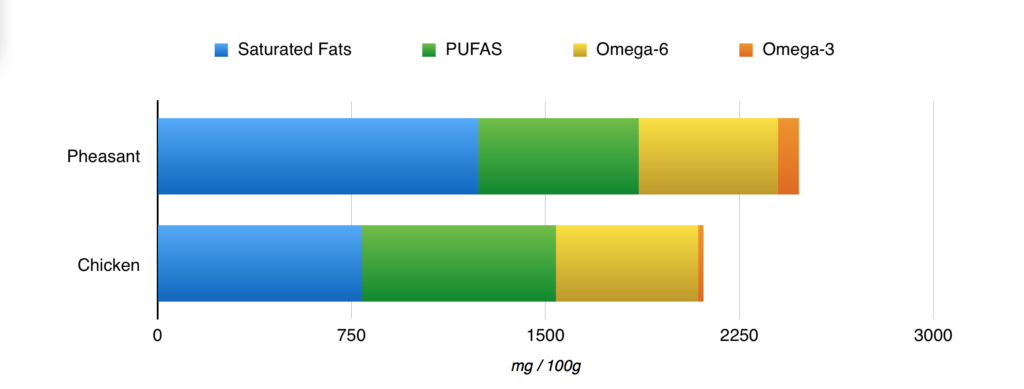
Compared to game poultry, chicken is lower in saturated fat, a bit higher in PUFAs but, like beef, much lower in omega-3 fats.
So let’s talk about how we can balance the fats to keep inflammation down. And there are a few foods we can add to balance the fats. Let’s take a quick look at these foods.
How To Balance The Omega-3 Fats
There are several foods available to help balance the fats in the foods we feed. Let’s take a quick look at each one:
Fish
Whole fish is a good addition to the diet. Not only is it high in omega-3 fats, it also contains a lot of important minerals and trace minerals. But you need to make sure you don’t feed fish from the Pacific because of radiation concerns … and all fish will contain heavy metals and toxins. And you want to feed small fish that only feed on phytoplankton, not bigger fish that eat other fish, because they’ll contain more toxins. Look for mackerel (from the Atlantic and not king mackerel), sardines and anchovies.
Fish Oil
I don’t recommend fish oil … ever. It’s not ocean-friendly and we should always consider the impact we have on the environment. But there are other problems with fish oil. First, fish oil will oxidize and turn rancid and this is not healthy for your dog. Fish oil is also lacking important minerals (and most dogs are deficient in minerals). I don’t love it and I’d much rather feed whole fish or phytoplankton, but I’m including it on the list in case you think you must feed it!
Green-Lipped Mussel Oil
Green-lipped mussel oil is rich in important EPA and DHA, like fish oil. But it’s better for your dog than fish oil. It contains 30 fatty acids, while fish and other marine oils only contain two. It also contains ETA (eicosatetraenoic acid). ETA is another omega-3 fatty acid with anti-inflammatory effects. Your dog can also convert ETA to EPA. EPA is known to regenerate cartilage, helping dogs with joint problems. Green lipped mussels are good for the planet too. They’re sustainably farmed in New Zealand waters, feeding on phytoplankton.
DNM RECOMMENDS: Four Leaf Rover offers Safe-Sea, sustainable and healthy combination of New Zealand Green Lipped Mussel Oil and Ahiflower oils. Buy Safe-Sea now >>
Ahiflower Oil
Ahiflower is a plant derived source of important omega fatty acids. Ahiflower contains GLA, an omega-6 fat that’s known to reduce inflammation. Ahiflower contains 60% more GLA (gamma linolenic acid) than hemp oil. Ahiflower also has SDA (stearidonic acid) … more than than any other plant source. SDA is a precursor for EPA, the anti-inflammatory omega-3 found in fish oils. And ahiflower oil has a ratio of omega-3 to omega-6 of 4:1, so it helps with omega fatty acid balance.
Coconut Oil
I’ve included coconut oil to my list because it’s often misunderstood. Dog owners like to add coconut oil because they believe it’s a healthy addition to the diet. But it won’t correct any fatty acid imbalances because it’s very high in omega-6 fats and low in omega-3. Overall, it contains very little of them, so it will never balance the omega-3 fats. And research now shows that coconut oil may cause gut inflammation.
Hempseed Oil
Hemp oil is extracted from hemp seeds. You might be thinking it’s marijuana but it contains no THC so it’s safe and nutritious. The nice thing about hemp oil is that it contains minerals (and vitamins) and it doesn’t contain phytic acid like many other plants (phytic acid can block the absorption of the minerals zinc, iron and copper). You’ll want to look for a cold pressed source that hasn’t been heated or extracted with hexane. It contains a good ratio of 6:3 so it can help control inflammation — but not a lot of the omega-3 can be converted to EPA and DHA.
Flaxseed Oil
Flaxseed oil is the last plant oil on the list. Flax contains a lot of omega-3 and that’s a definite benefit … but flax also contains the anti-nutrient phytic acid, which will rob your dog of some minerals. Many dogs also have allergic reactions to flaxseed and, like hemp, not all of the omega-3 fats can be converted to EPA and DHA (again, these are important to eye and brain health). I don’t really recommend flax, but a lot of dog owners feed flaxseed oil, so again, I put it on the list. As with hemp oil, make sure your flaxseed oil is cold pressed.
Plant Oils
With the exception of ahiflower oil and hempseed oil, I don’t recommend any other plant oils. Most of them contain the anti-nutrient phytic acid. And most contain large amounts of omega-6 fats. It’s the waste from plant oils that’s fed to food animals that makes them high in omega-6, so adding plant oils to your dog’s food is doubling down on the fat imbalance. Most plant oils can also oxidize like fish oil, and this oxidation can cause dangerous reactions in the cells of the body. They also make substances called eicosanoids in the body, which are modified fats that create inflammation in the cells (and because we want to add fats to reduce inflammation, this doesn’t seem like a very good idea at all). They’re also loaded with dangerous trans fats. So hemp oil and coconut oil are the only plant oils I recommend.
OK, now we know a bit about the foods we can add to balance the fats in our dog’s diet. Let’s put this all together and make it easy! We’ll look at how to balance beef, lamb and goat, and then we’ll look at balancing the fats in poultry.
Balancing The Fats In Beef and Ruminants
Beef, lamb and goat need to be balanced. They are:
- High in saturated fat
- Low in PUFAs
- Low in omega-3 fats
So, to balance beef, we need a food that’s low in saturated fat, higher in PUFAs and high in omega-3 fat. We have a few food choices available to us. Let’s take a look …
The foods most suitable to balance the fats in beef, lamb and goat are whole fish, fish oil, green-lipped mussel oil, hempseed oil. Coconut oil is much too unbalanced and much too high in saturated fat; and flaxseed oil, even if it was a safe choice, is too low in omega-6 fats. The object isn’t to reduce omega-6, because it’s the fat that’s most likely to cause skin issues if there’s not enough in the diet. So omega-6 fats are important … but they just need to be balanced with a good helping of omega-3 fats.
We’ll talk about how much to feed in a bit … but let’s look at poultry next.
Balancing The Fats In Poultry
Poultry has a different fatty acid profile than beef. Poultry is:
- Low in saturated fat
- High in PUFAs
- High in omega-6 fats
- Low in omega-3 fats
Because poultry is different from beef, we need to add different foods to balance the fats.
There aren’t as many foods or oils you can add to poultry because the PUFAs in poultry are already too high. But you can add whole fish which will do a good job helping to balance the omega-3 fats. Fish oil isn’t a good choice in this case because it’s also high in PUFAs, and the same applies to hempseed oil.
So now that you know what foods will balance the fats in your dog’s diet, you’ve got one missing piece of information … how much to feed! Let’s look at that next …
Amounts Of Fats To Give
So now I’m ready to put a big old bow on this for you! Let’s see how much of each food you need to add to your dog’s diet to balance it out.
Now there’s one disclaimer … you need to be feeding lean meats if you plan on adding fats to your dog’s diet. Too much fat in the diet can rob your dog of critical nutrients. Read more about managing the fat content in your dog’s diet.
Whole Fish
Recommended. Can be fed with both ruminants and poultry.
Amount: Feed 1 oz fish for every lb of ruminant and 4 oz for every lb of poultry.
Fish Oil
Not recommended. If you must give it, feed with ruminants only.
Green-Lipped Mussel Oil
Recommended. Can feed with ruminants and poultry.
Amount: ¼ tsp per 25 lbs body weight
Ahiflower Oil
Recommended: Can be fed with ruminants and poultry.
Amount: Feed ¼ tsp for every 20-25 lbs of body weight
Hempseed Oil
Recommended. Feed with ruminants only.
Amount: Feed 2 to 3 tsp per lb of food.
Coconut Oil
Do not use it to balance the fats. May cause gut inflammation.
Amount: 1 tsp per 10 lbs body weight
Flaxseed Oil
Not recommended. If you must give it, feed with poultry only.
So now that you understand more about fats, you can be proactive and begin adding these foods to balance omega-3 fats in your dog … and prevent the inflammatory diseases that come with improperly balanced fats.

